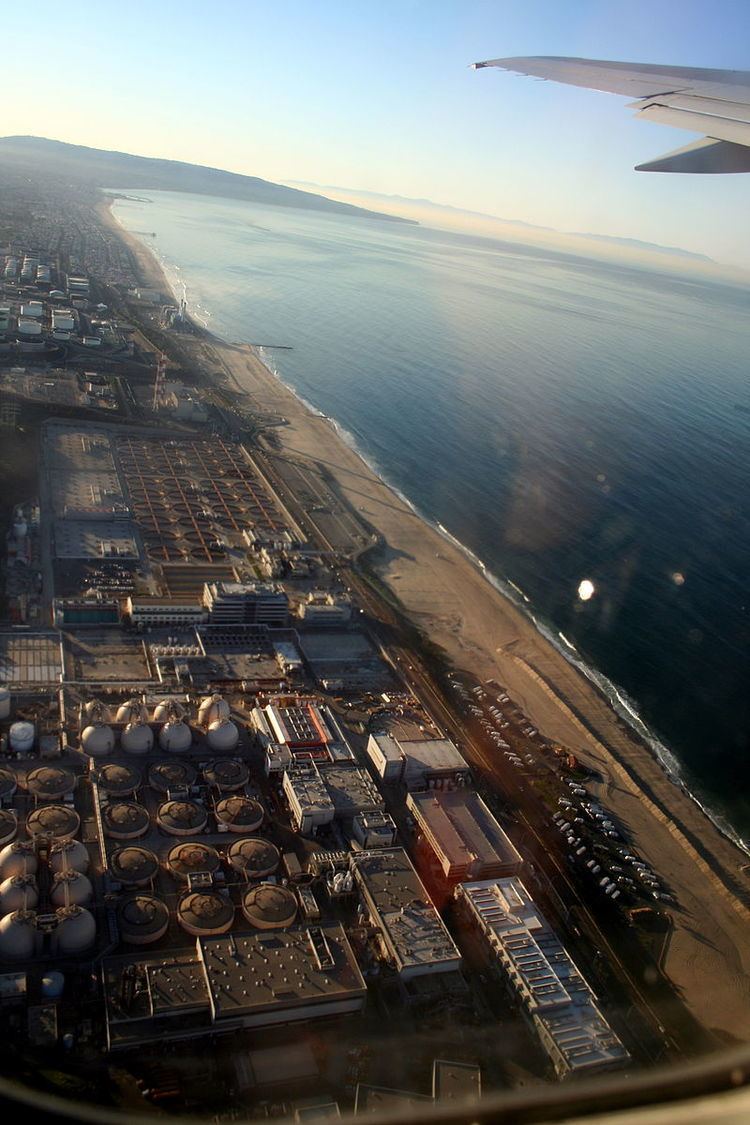Phone +1 310-648-5000 | ||
 | ||
Address 12000 Vista Del Mar, Playa Del Rey, CA 90293, USA Similar Hancock Memorial Museum, The Punk Museum, Ace Museum, Roslin Art Gallery, Angel's Knoll | ||
The Hyperion Water Reclamation Plant is located in southwest Los Angeles, California, next to Dockweiler State Beach on Santa Monica Bay. The largest sewage treatment facility in the Los Angeles Metropolitan Area, Hyperion is operated by the City of Los Angeles, Department of Public Works, Bureau of Sanitation.
Contents
History
Until 1925, raw sewage from the city of Los Angeles was discharged untreated directly into Santa Monica Bay in the region of today's Hyperion Treatment Plant.
With the population increase, the amount of sewage became a major problem to the beaches, so in 1925 the city of Los Angeles built a simple screening plant in the 200 acres (0.81 km2) the city had acquired in 1892.
Even with the screening plant, the quality of the water in Santa Monica Bay was unacceptable, and in 1950 the city of Los Angeles opened the Hyperion Treatment Plant with full secondary treatment processes. In addition, the new plant included capture of biogas from anaerobic digesters to produce heat dried fertilizer.
In order to keep up with the increase of influent wastewater produced by the ever growing city of Los Angeles, by 1957 the plant engineers had cut back treatment levels and increased the discharge of a blend of primary and secondary effluent through a five-mile (8 km) pipe into the ocean. They also opted to halt the production of fertilizers and started discharging digested sludge into the Santa Monica Bay through a seven-mile (11 km) pipe.
Marine life in Santa Monica Bay suffered from the continuous discharge of 25 million pounds of sludge per month. Samples of the ocean floor where sludge had been discharged for 30 years demonstrated that the only living creatures were worms and a hardy species of clam. Additionally, coastal monitoring revealed that bay waters often did not meet quality standards as the result of Hyperion's effluent. These issues resulted in the city entering into a consent decree with the United States Environmental Protection Agency and the California State Water Resources Control Board to build major facility upgrades at Hyperion. In 1980, the city launched a massive "sludge-out" project which upgraded the plant to full secondary treatment. Sludge digesters are used to destroy the disease-causing organisms (pathogens). The sludge-out portion of the program was completed in 1987.
The $1.6 billion sludge-out to full secondary construction program replaced nearly every 1950-vintage wastewater processing system at Hyperion while the plant continuously treated 350 million gallons per day (mgd) and met all of its NPDES permit requirements. As of 2016 the plant can treat 450 mgd, with a peak wet weather flow (partial treatment during storms) of 800 mgd.
The West Basin Municipal Water District purchases approximately 37,600 AF, or roughly 9 percent of Hyperion's secondary effluent for treatment at the Edward C. Little Water Recycling Facility.
In popular culture
Because of its hyper-industrial appearance, and its location within the thirty-mile "studio zone," the Hyperion plant has been used numerous times as a location for feature films and television shows, among them Battle for the Planet of the Apes and The Terminator.
A number of scenes for the The Monkees film Head were filmed inside the plant in early 1968. The shots included upstairs and downstairs angles, the use of a crane and an assembly line, and a general walk-through of the main part of the plant with the Monkees and actor Charles Macaulay ("Inspector Shrink").
In an episode of the TV detective series Cannon (Season 1, Episode 16: "The Treasure of San Ignacio;" January 11th, 1972), Frank Cannon calls on a retired detective to help him recover stolen religious relics from a Mexican church. In the finale, Cannon tracks down the sole surviving thief to the Hyperion plant (marked "condemned" by a sign on the building) and rescues the priest from the church with the help of the thief's girlfriend and his retired detective friend.
A key scene in the 1973 film Soylent Green was shot at the plant. It portrayed the factory that produced the bland yet nutritious "Soylent" wafers.
The plant is featured in several scenes in the 1956 science fiction film Earth vs. the Flying Saucers. It's used to portray a science laboratory where a weapon is developed for use against the invading UFOs. The same area of the plant was also used for several scenes in the film Angry Video Game Nerd: The Movie.
Used as the filming location for the final scene in the music video for t.A.T.u.'s "White Robe", filmed in October 2007.
